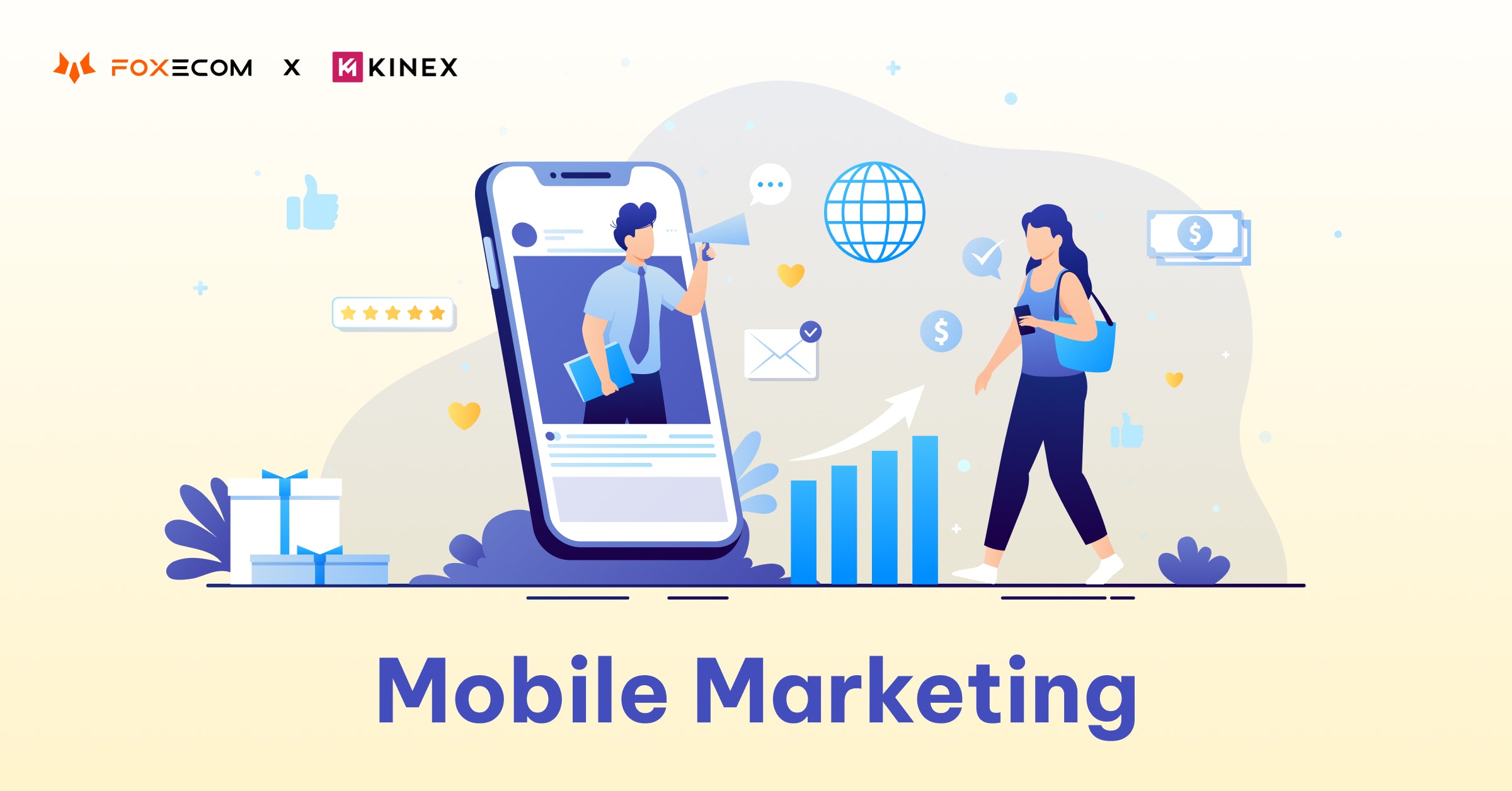More and more people are using smartphones for all their internet needs – preferring them over desktop computers. For marketers, this means they must adopt new approaches to reach the rapidly growing class of mobile users.
Successful mobile advertisements will be those that are prominent and meet users' needs rather than providing unnecessary content.
One advantage is the availability of free apps, which can help in learning how to effectively do shopify development mobile marketing.
What is Mobile Marketing?
Mobile marketing is a method of reaching people by sending messages through their cell phones and tablets. It leverages familiar apps like social media and texting, but they're tailored for smaller screens and mobile browsing habits. While some marketing techniques may not work well on mobile devices, others capitalize on mobile-specific features.

Image source: Investopedia
What is Mobile Experience?
The mobile-first marketing experience refers to how your customers feel when they use a mobile application or visit your website on their smartphones. It's all about making it easy to use and enjoyable.
Designing a mobile website requires a thoughtful strategy. Since many people use their devices to access sites and apps, having mobile-friendly sites and apps is crucial for reaching customers.

Image source: Appetiser Apps
Over 50% of marketers customize their mobile experience to improve search engine results (SEO), and one-third focus on mobile design to attract new customers. Google has been using mobile page load speed as a primary indicator to determine a mobile website and its ranking in search results for years.
Harness Mobile Power
Modern smartphones offer unique features for mobile-first marketing:
- Location Services: Provide check-in awards or location-related deals.
- Click-to-Call: To simplify your clients’ access to you, provide them with direct communication means.
- QR Codes: The link in our bio can be utilized to direct traffic to special offers or content.
Design for small screens:
- Concise Content: Give your opinion on the relevant points and make it easy to read.
- Clear Formatting: Create a hack headline, bullet points, and short paragraphs.
- Large, Thumb-Friendly Buttons: Go for click-to-calls (CTAs) for easier tapping.
Why It Matters
Mobile users seek convenience. By utilizing native smartphone apps that adapt to device capabilities, you can provide a better and more versatile experience, pleasantly surprising your users.
Tips to Optimize Your Website’s Mobile Experience

Image source: sinch
Develop empathy for your users
To create excellent mobile marketing experiences, it's crucial to grasp your users' viewpoints. Keep this in mind: you're not designing for yourself, so stepping beyond your own biases is vital.
The most effective approach to understanding your users is by directly engaging with them. Observe their interactions with your mobile site, empathize with their frustrations, and comprehend their objectives. Identify the issues they encounter and utilize these insights to enhance your design.
Having a comprehensive understanding of your mobile users is paramount for delivering impactful marketing experiences. This involves leveraging tools like customer journey maps, which help visualize every touchpoint in the user’s interaction with your site, emotion levels, and potential improvement areas. It illustrates their desires, how they utilize your site, and potential obstacles they may face. This tool can be extremely beneficial for pinpointing areas requiring improvement.
Keep it Simple for Mobile Users
Developing a mobile website relies on making straightforward decisions. This means focusing on the key elements since the small screen won't have room for clutter. Keep in mind that simplifying the interface makes it easier for users, but it doesn't have to be boring. However, a simple design can still be visually appealing and impressive.
Ensure that important aspects aren't hidden on the mobile version of your website. Avoid situations like promoting the app instead of providing informational content or displaying "wet paint" notices for missing features. The main goal is to effectively present the same information and functionality on both desktop and mobile sites.
Consider redesigning the overall appearance and removing less essential elements. Prioritize presenting clear information and always guarantee a seamless browsing experience across devices.
Design clear navigation
The main disadvantage of a mobile website is that space is limited, so navigation must be accurate. Users often prefer the three-line icon because it's compact and can be placed anywhere on the website.
However, users explore not only because of this limitation but also because they seek a place to stretch themselves and see what happens. Do users get lost in your site's structure? Is it unclear? Can they complete essential tasks quickly? Opting for a beautiful menu over a well-organized shop won't suffice.
Keep it simple. Fewer pages can mean a cleaner user interface. Ensure you're ready for testing after redesigning the navigation! Observe user behaviors and refine the interface accordingly.

Image source: Dribbble
Implement responsive design
Media queries and adaptive rendering of web pages on your website for users with different devices are collectively known as responsive design. This approach ensures that your website adjusts seamlessly to various screen sizes, akin to liquid filling a container.
Why is it important? Responsive design eliminates the need for creating multiple websites to accommodate different screen sizes. It plays a crucial role in enhancing the user experience, regardless of the device being used.
To illustrate, imagine a user-friendly website as a versatile pair of jeans that adapts to any situation or body type. Conversely, a non-responsive website is like a tailored suit – it may fit well on one person but appears ill-fitting on others.

Image source: Computing Australia
Don't neglect speed
The convenience and beauty of a mobile site depend heavily on its loading speed. Users aren't always patient – even a slight delay could send them to your competitors. On the flip side, Google considers site speed in its rankings.
A major drawback of websites is the delay on mobile devices. Limited processing power and spotty connections can slow them down. Prioritize speed in every aspect. Regularly test to ensure everything runs smoothly.
Speed optimization requires effort, but it's worthwhile. Faster page load times improve user experience, reduce drop-offs, and may increase conversion rates.
Check out the article on "Website performance," focusing on advanced techniques to boost your site's speed.
Consider interaction cost
Consider what your user experiences with your service elements. Do they encounter difficulty completing basic tasks on your mobile site? Interaction cost refers to the mental and physical energy needed to complete an action. Unlike a mouse click, each touch on a phone screen prompts an immediate reaction.
Having to fill in numerous fields can be a hindrance for users. Ensure that forms on your mobile site are concise, requesting only essential information.
Addressing frustrating features for mobile users is crucial. Avoid small fonts, persistent advertisements, and complex menus, as they hinder video viewing. The website's simplicity is key, drawing users to engage with it.
Make your writing neutral or language-friendly
If you're writing for your website, make sure the words you use appeal to your readers. Avoid mentioning specific devices like "iPhone" or actions like "click." Instead, opt for words like "select" or "choose" instead of "pick" to cater to mobile users.
Although it may seem small, this feature signals to mobile users that you're considering them. Using language that only works for desktop users can alienate those who work in offices. Embracing diversity demonstrates respect for all users.
Reduce Pop-ups and Interstitials
In mobile-first marketing pop-ups and interstitials can be particularly disruptive, making it difficult for users to access the content they came for. They can also slow down page load times and increase user frustration, leading to higher bounce rates and lower engagement. Moreover, Google has implemented guidelines discouraging the use of intrusive interstitials, particularly those that cover a significant portion of the screen or are difficult to dismiss, as they can affect search rankings.
To create a more user-friendly mobile experience, website owners should consider alternative strategies for delivering promotional messages or gathering user information, such as using less intrusive banners or inline forms that blend seamlessly with the content. By reducing the reliance on pop-ups and interstitials, websites can improve usability, enhance user satisfaction, and ultimately drive better engagement and conversions on mobile devices.
If you want to deliver mobile-first marketing experiences seamlessly, let’s take the power of Zest, a flexible Shopify theme that helps you to build a mobile-optimized online store and dominate mobile commerce at a glance.
Optimize Images and Multimedia
Optimizing images and multimedia content for mobile marketing involves several techniques aimed at improving performance, reducing bandwidth usage, and enhancing the overall user experience. One essential aspect is compressing images without compromising quality. This can be achieved by using image compression tools or formats like WebP, which offer smaller file sizes while maintaining visual fidelity. Additionally, implementing responsive images ensures that the appropriate image size is delivered based on the user's device and screen resolution, reducing unnecessary data consumption.
Moreover, employing lazy loading techniques can significantly enhance mobile experience by deferring the loading of images and multimedia content until they are needed, thus reducing initial page load times. This approach is particularly beneficial for long-scrolling pages where numerous images may be present. By loading content dynamically as users scroll, you can prioritize critical resources and provide a smoother browsing experience.
Don’t miss mobile in your marketing
The need to implement a mobile-first marketing approach or any mobile strategy can be daunting for online business owners. Initially, it requires time, effort, and money to design a website that satisfies mobile users. Moreover, many still believe that desktop websites are superior, questioning the necessity of catering to mobile users.
However, considering that both mobile and desktop users contribute significantly to internet traffic, investing in mobile design becomes imperative. Mobile users likely already constitute a substantial portion of your website's traffic. As per stats, 52.2 percent of all website traffic is generated from mobile phones.
It's essential to recognize that optimizing mobile experience is a continuous process, not a quick fix. Understanding user preferences takes time. Analyzing website performance and making necessary adjustments won't happen overnight. Nevertheless, perseverance yields conversions and benefits from this influential user group.
If you want to design an online store that is optimized for both desktop and mobile, let’s try Zest, a flexible and modern Shopify theme that helps you to dominate m-commerce and win conversion.





